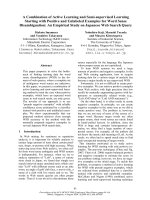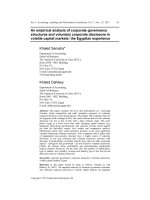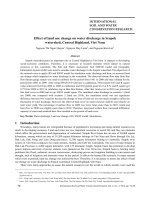Effect of gender composition and negotiation support systems in dyadic setting an empirical study
Bạn đang xem bản rút gọn của tài liệu. Xem và tải ngay bản đầy đủ của tài liệu tại đây (477.5 KB, 114 trang )
EFFECT OF GENDER COMPOSITION AND
NEGOTIATION SUPPORT SYSTEMS IN DYADIC
SETTING: AN EMPIRICAL STUDY
WANG ZHEN
NATIONAL UNIVERSITY OF SINGAPORE
2007
i
EFFECT OF GENDER COMPOSITION AND
NEGOTIATION SUPPORT SYSTEMS IN DYADIC
SETTING: AN EMPIRICAL STUDY
WANG ZHEN
B. Computing (Hons.), NUS
A THESIS SUBMITTED
FOR THE DEGREE OF MASTER OF SCIENCE
DEPARTMENT OF INFORMATION SYSTEMS
SCHOOL OF COMPUTING
NATIONAL UNIVERSITY OF SINGAPORE
ii
ACKNOWLEDGEMENT
First and foremost, I would like to thank my supervisor, Professor John Lim, for
guiding me throughout this research project. Without him, this thesis would not exist.
His insightful inputs and timely guidance greatly helped me to the successful
completion of this research. I am grateful to be his student. I would like to sincerely
thank him for his utmost inspirations.
I would also like to extend my appreciation to:
Ms. Yang Yin Ping, for her continual support in my research and her
permission to conduct the experiment with the software developed by her.
Professor Chan Hock Chuan and Dr. Sharon Tan, the two examiners of my
graduate research proposal and master thesis, for kindly evaluating my project
and their invaluable comments;
Ms. Elizabeth Koh, for her help on editing this paper.
My dear friends – Ms. Guo Xiao Jia, Ms. Zhong Ying Qin, Ms. Xu Heng, Ms.
Liu Na, Ms. Tong Yu, Mr. Zhang Dong, Mr. Zheng Jun, for their forbearance
and constructive criticisms.
I would like to express my special thanks to my families, for their constant support
and encouragement to keep me going on. I sincerely thank them for giving me their
utmost considerations and understanding throughout this study.
June 2007
Wang Zhen
iii
Table of Content
ACKNOWLEDGEMENT ..................................................................................................................... III
ABSTRACT
……………………………………………………………………………………...VII
CHAPTER 1
INTRODUCTION................................................................................................... - 1 -
1.1
BACKGROUND AND MOTIVATION .........................................................................- 1 -
1.2
SCOPE AND OBJECTIVES .......................................................................................- 3 -
1.3
ORGANIZATION OF THESIS ....................................................................................- 4 -
CHAPTER 2
2.1
LITERATURE REVIEW....................................................................................... - 5 -
NEGOTIATION........................................................................................................- 5 -
2.1.1
An Overview of Negotiation Literature ......................................................................... - 5 -
2.1.2
Negotiator Characteristics............................................................................................. - 8 -
2.1.3
Negotiation Process ....................................................................................................... - 9 -
2.1.4
Situational Factors....................................................................................................... - 17 -
2.2
NEGOTIATION SUPPORT SYSTEMS (NSS)............................................................- 20 -
2.2.1
Motivation of Developing NSS..................................................................................... - 23 -
2.2.2
Components of NSS...................................................................................................... - 28 -
2.2.3
Classification of NSS.................................................................................................... - 30 -
2.2.4
Empirical Research on NSS ......................................................................................... - 32 -
2.3
GENDER AND NEGOTIATION ...............................................................................- 43 -
2.3.1
Background Overview.................................................................................................. - 43 -
2.3.2
Negotiation Strategies.................................................................................................. - 45 -
2.3.4
Dyadic Gender Composition ....................................................................................... - 47 -
CHAPTER 3
RESEARCH MODEL AND HYPOTHESES .................................................... - 51 -
3.1
RESEARCH MODEL .............................................................................................- 51 -
3.2
RESEARCH HYPOTHESES ....................................................................................- 53 -
3.2.1
Interaction Effect of Gender and Availability of NSS.................................................. - 53 -
3.2.3
Strategy Dimensions and Negotiation Outcome.......................................................... - 58 -
CHAPTER 4
RESEARCH METHOD ....................................................................................... - 61 -
4.1
EXPERIMENT DESIGN ..........................................................................................- 61 -
4.2
SUBJECTS ............................................................................................................- 62 -
4.3
EXPERIMENT TASK..............................................................................................- 62 -
4.4
EXPERIMENT MANIPULATION .............................................................................- 63 -
iv
4.4.1
Independent Variables ................................................................................................. - 63 -
4.4.2
Control Variables......................................................................................................... - 64 -
4.5
EXPERIMENTAL PROCEDURE ..............................................................................- 65 -
4.6
MEASUREMENT OF DEPENDENT VARIABLES ......................................................- 66 -
4.6.1
Dimensions of Negotiation Strategy ............................................................................ - 66 -
4.6.2
Negotiation Outcome ................................................................................................... - 68 -
CHAPTER 5
DATA ANALYSIS ................................................................................................ - 70 -
5.1
OVERVIEW ..........................................................................................................- 70 -
5.2
VALIDATION TESTS .............................................................................................- 70 -
5.2.1
Manipulation Test ........................................................................................................ - 70 -
5.2.2
Control Check .............................................................................................................. - 70 -
5.2.3
Scale Validation ........................................................................................................... - 71 -
5.3
CODING OF THE PROCESS VARIABLES ................................................................- 72 -
5.4
HYPOTHESES TESTS ............................................................................................- 73 -
5.4.1
The Interaction Effects ................................................................................................. - 73 -
5.4.2
The Effects of Process Variables on Outcome Variables............................................ - 76 -
CHAPTER 6
6.1
DISCUSSION AND IMPLICATION ................................................................. - 78 -
DISCUSSION OF RESULTS ....................................................................................- 78 -
6.1.1
Interaction Effect on Process Variables....................................................................... - 78 -
6.1.2
Effects of Strategy Dimensions on Negotiation Outcomes.......................................... - 82 -
6.2
IMPLICATIONS .....................................................................................................- 84 -
6.3
LIMITATION AND FUTURE RESEARCH .................................................................- 86 -
CHAPTER 7
CONCLUSION...................................................................................................... - 88 -
REFERENCES ……………………………………………………………………………………- 89 APPENDIX A: BACKGROUND INFORMATION OF NEGOTIATION CASE ................. - 103 APPENDIX B: PRE-NEGOTIATION QUESTIONNAIRE.................................................... - 106 APPENDIX C: POST-NEGOTIATION QUESTIONNAIRE ................................................. - 107 -
v
List of Figures and Tables
Figure 1: Multi-Stage Model of Bilateral Negotiation.......................................................... - 7 Figure 2: The Theoretical Model of NSS............................................................................ - 29 Figure 3: Proposed Research Model ................................................................................... - 52 Figure 4: Experimental Design ........................................................................................... - 62 Figure 5: NSS Interface ...................................................................................................... - 63 Figure 6: Interaction Effect of Degree of Cooperativeness ................................................ - 74 Figure 7: Interaction Effect of Degree of Assertiveness..................................................... - 74 -
Table 1: The Dual Concern Model: Strategy and Joint Outcome ....................................... - 10 Table 2: NSS Prototypes..................................................................................................... - 21 Table 3: Major Stumbling Blocks of Human Negotiator.................................................... - 25 Table 4: Experimental Studies of NSS in Literature........................................................... - 34 Table 5: Coding Scheme..................................................................................................... - 67 Table 6: Pre-experimental Group Differences .................................................................... - 71 Table 7: Psychometric Properties of the Measurement on Satisfaction.............................. - 72 Table 8: Descriptive Statistics of Cooperativeness and Assertiveness ............................... - 73 Table 9: The summary of the Two-way ANOVA results ................................................... - 74 Table 10: One-Way ANOVA Test of Degree of Assertiveness ......................................... - 75 Table 11: Summary of One-Way ANOVA Test................................................................. - 76 Table 12: Summary of Process Variables’ Effect on Negotiation Outcome ....................... - 76 Table 13: Summary of Hypotheses Tests ........................................................................... - 77 -
vi
ABSTRACT
Many empirical studies have shown that negotiation support systems (NSS) generally
improve negotiation performance. While most research on NSS has focused on
functional and structural issues, the investigation of negotiator characteristics is
largely limited. Gender has been considered as one characteristic with great direct
relevance in the context of negotiation. This paper empirically examined the
interaction effect of gender composition and availability of NSS. To open the ‘black
box’ of negotiation process, we investigated the two dimensions of negotiation
strategy: degree of cooperativeness and degree of assertiveness. The results of this
study showed that NSS support did help negotiators to achieve higher degree of
cooperativeness, which was a significantly positive predictor of joint outcome and
contract balance. Degree of assertiveness was jointly influenced by gender
composition and availability of NSS. Dyads with higher degrees of assertiveness
achieved agreements with greater joint outcome. The differential effects of gender
composition on these two strategic dimensions were observed. Implications of
findings were discussed in detail.
Key Words:
Negotiation support systems (NSS), negotiation strategy, gender composition,
negotiation process
vii
CHAPTER 1
INTRODUCTION
1.1 Background and Motivation
Negotiation is a common but challenging task in a managers’ day-to-day life. It has
been studied from many disciplines, including sociology, psychology, political
science, economics, applied mathematics, computer science and artificial intelligence
(e.g., Cohen, 1991; Barry & Friedman, 1998; Lewicki et al., 2003). Bargainer
characteristics, situational constraints and the process variables of negotiation are the
three classes of factors that determine negotiation outcomes (Campbell et al., 1988).
In the negotiation literature, there are two schools of studies: descriptive model
focusing on the process of negotiation, and prescriptive model, which emphasizes on
the outcomes of negotiation (Kersten & Cray, 1996). These two different approaches
have different assumptions and focuses, yet complement each other. Together, they
jointly depict a more complete picture of negotiation.
With the fast development of IT technology, there is an increasing use of NSS in both
internal and external negotiations. Recent empirical research on Negotiation Support
Systems (NSS) has shown that computer-aided negotiations generally yielded higher
joint outcomes (i.e., total utilities for all parties), better contract balance (fairer
outcome), and greater satisfaction. In short, the use of NSS helps to improve
negotiation processes and outcomes (e.g., Delaney et al., 1997; Goh et al., 2000;
Jones, 1988; Rangaswamy & Shell, 1997). As NSS is still at its exploratory stage,
published NSS studies mainly belong to the prescriptive model, which focuses on the
-1-
input and output of negotiation, and leaves the negotiation process as a black box.
There is a lack of understanding of what happens in the negotiation process and how
negotiation activities lead to the final outcomes, especially in computer-supported
circumstances.
Among the published NSS researches, functional models (e.g., DSS model, electronic
communication, negotiation agents) and structural factors of negotiation (e.g., the
amount of conflict between the negotiators, the nature of the negotiation problem) are
the most popular areas. However, there is little work done to investigate the issues
raised by the characteristics of negotiators in the NSS literature. To better understand
and facilitate negotiation, the effects of individual differences have caught increasing
attention recently (Lewicki et al., 2003; Vetschera, 2006). Despite the development of
NSS, selecting the right people and providing appropriate training are also important
to increase the efficiency and utility of negotiation.
Some people can achieve better negotiation outcomes than others. Differences in
gender, personalities, ability, negotiation experience, and communication style have
been noted to impact the negotiation process and outcomes (e.g., Lewicki et al., 2003;
Pruitt, 1981; Simintiras & Thomas, 1998; Barry & Friedman, 1998). Among these
proposed individual differences, gender has been considered as one with greater direct
relevance in the context of negotiation (Kray et al., 2001; Lewicki et al., 2003). A
group of studies (Rubin & Brown, 1975; Thompson, 1990; Gayle et al., 1994; Krone
-2-
et al., 1994; Walters et al., 1998) have reported that men and women behaved
differently, and consequently achieved dissimilar outcomes in negotiation.
Consistently, the study of feminist theory also considers negotiation as a gendered
activity (Kolb & Putman, 1997). Today’s workforce consists of a large extent of
women. Some of them become negotiation representatives of organizations, where
negotiation was the male-dominated job historically. Therefore, it is timely and useful
to examine the gender effects in negotiation.
1.2 Scope and Objectives
This study aims to foster a better understanding of how gender impacts the
negotiation process and outcomes. We propose a model to delineate the interaction
effect of gender composition and availability of computer supports on negotiation
process, through which influences the final negotiation outcomes. Theoretically, this
study puts forth a NSS research model by integrating both descriptive and prescriptive
perspectives. Practically, it could provide knowledge to managers preparing and
carrying out successful negotiations with awareness of the potential gender effects.
NSS developers would also further enhance the systems to better facilitate both male
and female negotiators. Thus, the purpose of this research is twofold: (1) to determine
the extent to which gender influences the negotiation processes and outcomes in NSS
context, and (2) to investigate the black box of negotiation process from the
negotiation strategy perspective.
-3-
1.3 Organization of Thesis
This paper is organized as follows. The next chapter provides the literature review of
negotiation, negotiation support systems, and the role of gender in negotiation.
Afterwards, the research model and hypotheses are presented. In the following
chapter, the research method is reported. In chapter 6, the data analysis of this study is
provided. Next, findings and implications are discussed. Finally, we conclude the
paper with a discussion of future research topics.
-4-
CHAPTER 2 LITERATURE REVIEW
Three aspects that would affect the negotiation process and outcome in the research of
NSS have been suggested: functional models (e.g., DSS model, electronic
communication, negotiation agents), characteristics of negotiators (e.g., gender,
ability, personality), and structural factors of negotiation (e.g., the amount of conflict
between the negotiators, the nature of negotiation problems). In this section, the
literature of negotiation and NSS are reviewed. Subsequently, gender effects in
negotiation are discussed in detail.
2.1 Negotiation
2.1.1
An Overview of Negotiation Literature
Negotiations have been studied from many perspectives including sociology,
psychology, political science, economics, applied mathematics, computer science and
artificial intelligence, etc (e.g., Cohen, 1991; Ikle & Leites, 1962; Pruitt, 1981).
Gulliver defined negotiation as ‘a process in the public domain where two parties,
with supporters of various kinds, attempt to reach a joint decision on issues in dispute’
(Gulliver, 1979, p. 79). It is a special form of communication that centers on
perceived incompatibilities and focuses on reaching mutually acceptable agreements
(Putnam & Roloff, 1992).
Negotiation is a means through which two or more parties can resolve conflicts, and
enter into agreements (Walters et al., 1998). It also concerned with how individuals
-5-
attempt to acquire a multitude of organizational privileges and resources, such as
status, power, respect, and recognition (Eagly, 1995). From the perspective of social
exchange theory, negotiation is a dynamic process characterized with information
exchange, persuasion, and joint problem solving (Alexander et al. 1994). These
definitions above highlight the mixed motive nature of negotiation (Hopmann, 1996),
where negotiators maximize their and/or others’ outcomes. This encourages
negotiators to adopt advanced technologies in a dispute resolution process.
Weigand et al. (2003) summarized five basic features of negotiation:
There are two or more parties in a situation of some kind of interdependence,
Each has some individual goals which may be partially incompatible,
In some form of the negotiation process,
Alternatives are investigated,
Of which one is mutually agreed upon as the acceptable outcome of the process.
In a negotiation process, there are four main stages (Lim, 1999), where negotiators
have different focuses (see Figure 1). The first stage is to identify the key issues of the
current negotiation task. In the second stage, negotiators have to estimate the range of
each issue identified previously. Based on the outcomes generated from stage 2,
negotiators define utility functions of theirs and estimate their opponents’ in stage 3.
In the last stage, negotiators perform the negotiation dance. At each stage, some
computerized tools have been proposed to assist negotiators.
-6-
Figure 1: Multi-Stage Model of Bilateral Negotiation (Lim, 1999)
Theoretical Perspectives of Negotiation
In the literature of negotiation studies, descriptive model and prescriptive model are
the two major schools of approaches from various disciplines, such as sociology,
psychology, organizational behavior, economics, etc. While descriptive model focuses
on the process of negotiation, the prescriptive model emphasizes on the inputs and
outputs of negotiation (Kersten & Cray, 1996). These two approaches are not
mutually exclusive, but rather complement with each other.
Descriptive model of negotiation is widely studied in social behavior science,
sociology, and psychology. Based on sociological and psychological theories of
learning and joint decision-making (Lim & Benbasat, 1993), the descriptive model
seeks to describe what actually happens in the negotiation process (Weigand et al.,
2003). With descriptive approach, researchers focus on cognitive processes of
-7-
judgment, behavior, and outcomes in negotiation (Thompson, 1990), individual
differences (Hausken, 1997; Ford, 1983), contextual characteristics of negotiation
(Stuhlmacher & Champagne, 2000), and situational determinants (Pruitt & Rubin,
1986a, b), etc.
Prescriptive model of negotiation stems from the studies of Game Theory, social
psychology and organizational behavior. Its fundamental assumption is axiomatic
rationality, where participants will always choose the options that are in their best
interests according to the particular quality measurement instrument chosen. It is
normative in the sense that it prescribes what negotiators should do to achieve the
desired results (Weigand et al., 2003). While the theoretical objective of this
perspective is to predict the processes and outcomes of negotiation, the practical goal
is to help people negotiate more effectively (Raiffa, 1982). This approach is often
being criticized as too general or hypothetical, over-simplified, as it ignores the
process of negotiation and focus on outcomes. However, at the exploration stage of a
new phenomenon, this approach would be more effective in facilitating research by
simplifying the problem.
2.1.2
Negotiator Characteristics
Almost every negotiation involves people, thus it is essential to understand the
negotiator characteristics in the study of NSS. In the negotiation literature, gender
(Rubin & Brown, 1975; King & Hinson, 1994), personalities (Ford, 1983),
-8-
negotiation experience (Neale & Northcaft, 1991), communication style (Simintiras &
Thomas, 1998) have been noted to impact the negotiation process and outcomes
(Barry & Friedman, 1998; Lewicki et al., 2003; Pruitt, 1981). In this paper, we focus
on gender.
Gender has caught researchers’ attention in the negotiation research (Rubin & Brown,
1975; Thompson, 1990). It is considered as ‘one of the most important demographic
variables to investigate in a setting like negotiation where the situational pressures are
more apt to prompt behaviors consistent with gender roles’ (King & Hinson, 1994,
p610). In general, women are more cooperative; while men are more competitive in
conflicts (Gayle et al., 1994; Krone et al., 1994; Walters et al., 1998). In the third part
of this chapter, gender will be discussed in detail.
2.1.3
Negotiation Process
Negotiation process involves interaction process among parties and cognitive process
within each individual before reaching agreements. The interaction process consists of
communication among all participants, and behavioral enactments and executions of
negotiation strategies (Walton, 1987; Thompson, 1990). Through these activities, they
attempt to justify their positions and persuade opponents. The cognitive process
covers negotiation planning, information processing and affect (Neale & Northcraft,
1991). In short, the final agreement is jointly determined by conflict management
-9-
behavior and negotiator cognition of each party (Walton, 1987). The paper mainly
studies the interaction process, specifically, negotiation strategy and communication.
2.1.3.1 Negotiation Strategies
In negotiation, strategies govern an entire or a large part of the interaction. In game
theory domain, researchers usually try to determine the optimal strategy to reach
equilibrium. However, when it is not possible to get this optimal strategy due to
human limitation or resource constraints, negotiators may tend to use heuristics. Some
factors that may affect the choice of strategies have been proposed, such as negotiator
personalities, negotiation goals, and counterparty behaviors, etc. The most common
negotiation strategies identified include problem solving, yielding, contending and
avoiding (Pruitt & Rubin, 1986a; Pruitt, 2001). In the following part, these strategies
are discussed by incorporating the notion of Dual Concern Model (Pruitt, 1983; Pruitt
& Rubin, 1986a).
Table 1: The Dual Concern Model: Strategy and Joint Outcome
High self concern
Strategy
Joint Outcome
Low self concern
Strategy
Joint Outcome
High other
concern
Problem solving
(Collaborative)
High
Yielding
(Accommodating)
Low
Low other
concern
Contending
(Competitive)
Moderate
Inaction
(Avoiding)
Low
Dual Concern Model
It has been suggested that it would be more accurate to describe conflict-handling
behaviors by two dimensions: assertiveness and cooperativeness (Thomas & Kilmann,
- 10 -
1974; Ruble & Thomas, 1976; Thomas, 1976). The Dual Concern Model (see Table 1)
predicts negotiation outcomes as a function of a negotiator's concern of self profits
(assertiveness) and concern of the other's welfares (cooperativeness).
Problem Solving
An individual is considered using problem solving strategy, if he/she is assertive as
well as cooperative in negotiation. The problem solving conflict-handling style has
also been called as collaborative (Pruitt & Rubin, 1986) or integrative bargaining
(Walton & McKersie, 1965). The Dual Concern Model suggests that successful
integrative bargaining would be achieved by problem solving strategy, where
individuals tend to ‘expand the pie’ by looking for solutions. As a consequence, the
final agreement is likely to satisfy both parties, such that high joint outcomes could be
reached. However, negotiators may fail to maintain a high concern for both parties in
real practices.
When it is difficult to yield and contending seems infeasible or unwise, problem
solving strategy is likely to be adopted (Zartman, 2000). This strategy is more feasible
when the negotiation task has a high integrative potential. Pruitt (2001) summarized
the sources of perceived integrative potential: (1) faith in one’s own problem-solving
ability, (2) recent success in reaching agreement, (3) the presence of a mediator, (4)
the other party’s perceived readiness to change position, (5) trust in the other party is
interested in problem solving and will abstain from taking competitive advantage of
- 11 -
the negotiator. In addition, a good working relationship would also encourage the
adoption of problem solving strategy to increase the achievement of mutually
beneficial agreement and prosper future interaction.
Yielding
When individuals behave cooperatively and unassertively in a negotiation, they are
applying the yielding strategy. It is characterized by a self-sacrificial deference to the
other party’s needs (Walters et al., 1998). Yielding or accommodating may imply a
partial concession (Pruitt & Rubin, 1986), and reducing one’s aspiration (Ben-Yoav &
Pruitt, 1984b). With yielding strategy, individuals’ own concerns are unlikely to be
fully addressed. Instead, they will take away ‘influence, respect, and recognition
(Thomas & Kilmann, 1974, p. 16). Both problem solving and yielding improve the
chances of reaching agreement but with different cost. The former strategy is for the
benefit of both parties and the latter is at one’s own expense (Pruitt, 2001).
According to the Dual Concern Model, yielding strategy is likely to be used, if the
negotiator focuses on the opponent’s interests with very limited self-concern. Such a
strong other-concern would emerge when individuals are motivated to cooperate, or
have a positive mode, or expected a good future relationship in long run, or they have
good relationships with the opponent, or under time pressure (Pruitt, 2001). As a
result, they may miss the possibility of an integrative solution. Besides, their
aspiration may collapse easily, which leads to low joint outcomes. It is unlikely to use
- 12 -
this strategy, when there are some important issues derived from more basic concerns,
such as basic rights, self-esteem, ethical principle, etc. It is so hard to yield, if one’s
aspirations are close to his/her lower limit (Pruitt, 1981), or being hostile towards the
other party (Zubek et al., 1992). Besides, from agency theory perspective, it is more
difficult to yield if the negotiator is a representative rather than on one’s own behalf
(Benton & Druckman, 1973).
Contending
Negotiators with contending strategies tend to use threats, counter threats, arguments
for persuading concession, and positional commitments (Pruitt, 2001). According to
the Dual Concern Model, contending behavior results when an individual is highly
assertive and uncooperative. This type of behavior is considered as power-oriented,
where individuals are highly motivated to win or defeat their opponents (Thomas &
Kilmann, 1974). It is also known as claiming value. With the contending strategy,
negotiators can achieve joint outcomes at a moderate level (Pruitt & Rubin, 1986a;
Calhoun & Smith, 1999). The negotiators’ aim is the ultimate criterion to distinguish
between problem solving and contending (Pruitt, 2001).
It is more likely for negotiators to use contending strategy, when there is high
accountability to constituents (Ben-Yoav & Pruitt, 1984b), or when it is observed by
male constituents (Pruitt et al., 1986), or when one views the situation as “win-lose”.
Besides, great threats from the opponent would possibly stimulate the negotiator to be
- 13 -
contentious as well. Many studies have found that there is a high probability that both
parties in the negotiation use contentious strategies. Carnevale and Isen (1986)
suggested putting a barrier between the two negotiators to reduce the use of
contentious tactics. This barrier could be geographical distance, intervener, or
computer.
Avoiding
The last type of negotiation strategy identified by this model is avoiding, where a
negotiator is neither cooperative nor assertive. In such a case, the individual is
considered as inactive, or has withdrawn from the issue. Thus, the joint outcome is
low.
In summary, the Dual Concern Model explicitly assumes that the other-concern
dimension and self-concern dimension are independent. Factors affecting one
dimension may not necessarily have impacts on the other. Several studies have
provided supportive evidence of this assumption (e.g., Ben-Yoav & Pruitt, 1984a,
1984b; Carnevale & Lawler, 1986). Unlike economic models of negotiation assuming
that negotiators are rational and maintain a relative high degree of assertiveness and
cooperativeness, the Dual Concern Model posits negotiators differ in their level of
other-concern and self-concern.
2.1.3.2 Communication
- 14 -
Negotiation after all is a special kind of communication between two or more parties
to reach an agreement (Kimmel et al., 1980;Putnam & Roloff, 1992). It is a dynamic
process characterized by information exchange, persuasion, and joint problem solving
(Alexander et al., 1994). Research in social psychology and economics found that
negotiators systematically reach better outcomes than normative economic predictions,
if communication is allowed (Orbell et al., 1988; Sally, 1995).
Communication in negotiation serves four primary functions (Tutzauer & Roloff,
1988): (1) a vehicle for transmitting and accepting offers, (2) a means for conveying
information, (3) a mechanism for shaping the relationship between the bargainers
through argumentations, and (4) a lens for uncovering outcomes. The mode of
communication would affect both the efficiency of outcomes and the distribution of
available surplus (Valley et al., 1998). A series of studies conducted by Burgoon and
his colleagues (Burgoon et al., 1984; Burgoon & Hale, 1984, 1987; Burgoon &
Newton, 1991) have identified some dimensions of communication: intimacy,
composure or relaxation, formality, dominance or inequality, and task-social
orientation.
Neale and Northcraft (1991) summarized that research on communication in
negotiation has followed two lines: (1) the effects of communication on outcomes,
specifically the content and style, (2) the determinants of communication tactical
- 15 -
choices. For instance, investigating the effects of the electronic communication
channel in NSS is one of the research areas (Lim & Yang, 2004; 2005).
Social presence theory, media richness theory and social information processing
theory are the most popular theories developed and examined in communication
research. Social presence theory (Short et al., 1976) has been frequently applied in the
study of computer mediated communication (CMC). Social presence refers to one’s
feeling of the involvement of the other persons in a communication exchange.
Communication medium affects the perception of warmth and friendliness in an
interaction. This theory states that the higher the bandwidth of the communication
media, the greater the social presence of communicators. However, it is challenged
that it is the time limitations rather than bandwidth that hinder relationship building
through CMC. Originated in study on information processing, media richness theory
(Daft & Lengel, 1984; 1986) focuses on the number of cues available in different
media. It posits that there is an optimal match between the equivocality of
communication tasks and the selection of communication media. Richness refers to
the ability of each medium to convey messages (Daft et al., 1987). Explicitly rejecting
the notion that the absence of nonverbal cues limits relational communication, social
information processing theory (Walther, 1992) explains and predicts participants’
interpersonal accommodation via CMC and face-to-face (FtF) channels. Social
information processing refers to ‘the way by which communicator’s process social
identity and relational cues using different media’ (Walther, 1994, p.190). This theory
- 16 -
posits that social information is exchanged through the content, style and timing of
verbal message online, where time is a critical factor. Particularly, the perceived
differences in immediacy, composure, and receptivity between CMC and face-to-face
settings would be reduced over time.
2.1.4
Situational Factors
2.1.4.1 Bargaining Orientation
Bargaining situations of negotiations vary along the continuum between integrative
and distributive. Distributive negotiation is generally known as “win-lose”, “slicing
the pie” and “competitive” (Schelling, 1956). Negotiators aim to maximize their
individual outcomes. In this situation, negotiators focus on sub-optimal outcomes to
claim value, and try to achieve an efficient compromise (Kersten, 2001).
In contrast, integrative negotiation is known as “win-win” and “expanding the pie”. It
provides an opportunity for the parties involved to integrate their interests (Thompson,
1998) to create a solution that satisfies both parties. Walton and McKersie (1965)
noted the most important conditions leading to integrative agreement in negotiations
are simultaneous considerations of issues where mutual trade-off can be made,
problem-solving orientation, free and accurate information exchange, avoidance of
distributive behavior, and high aspiration in the negotiation process.
2.1.4.2 Severity of Time Pressure
- 17 -
Nearly every negotiation is conducted under certain time limitation explicitly or
implicitly. Time pressure is defined as either relatively short (high pressure) or long
(low pressure) for the time given in a negotiation. Time limitation may influence
people’s behaviors (Druskat & Kayes, 2000). Pruitt and Drews (1969) argued that
negotiation could be more effective with time pressure, as it could increase the
importance of reaching an agreement, reduce the number of options, and provide the
negotiators a concession rationale. Consistently, Stuhlmacher and Champagne (2000)
summarized three types of response processes in negotiation under high time pressure.
First, strong time pressures in the form of fixed deadlines would accelerate the
process toward agreement (Druckman, 1994; Maule & Mackie, 1990). A
meta-analytical study (Druckman, 1994) showed that negotiators yielded more under
high time pressure. Second, negotiators may process information selectively (e.g.,
being risk aversive) with time pressure (Svenson & Edland, 1987). Third, differential
combination of information would be generated as well (Edland & Svenson, 1993).
Empirical studies showed that high time pressure might also promote cooperative
behavior (Carnevale & Lawler, 1986), and sponsor agreement rather than impasses
(Stuhlmacher et al., 1998). However, suggested by Stuhlmacher and Champagne
(2000), at early stage of a negotiation, high time pressure might not affect the strategy
choices. Adjustments are likely being made more frequently as getting close to the
deadline. Their study also showed that under time pressure decisions could be
consistent, but the quality of agreements might vary.
- 18 -









